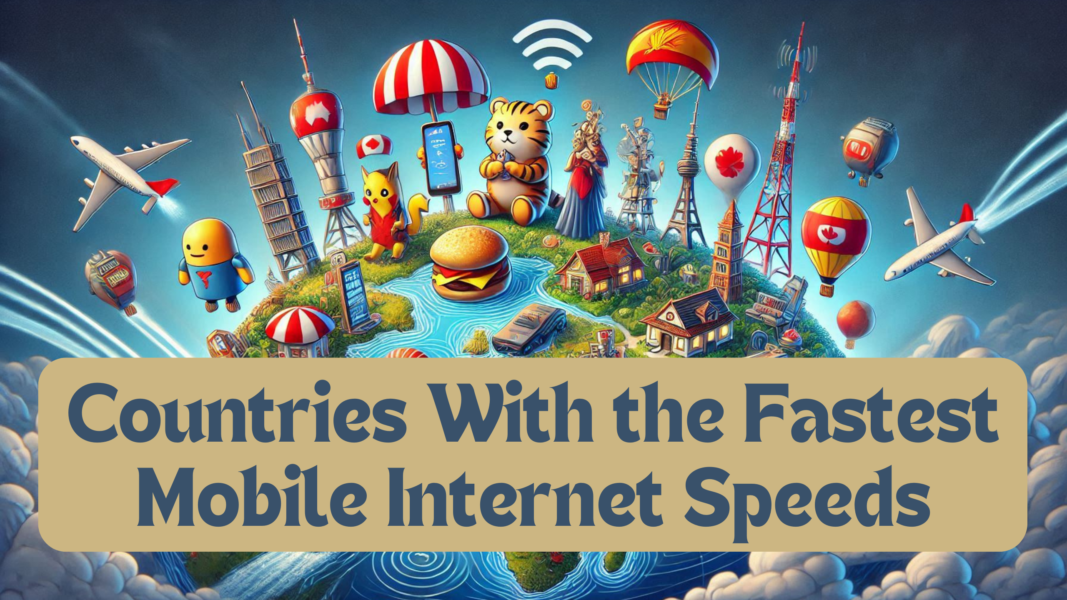In today’s digital age, mobile internet speeds are a vital metric of a country’s technological infrastructure. While billions of people have gained internet access over the past decade, there remain significant disparities in internet speeds and accessibility worldwide. Based on data from the World Bank, this TechyNerd article dives into the countries with the fastest mobile internet in 2023 and explores the socioeconomic factors driving these trends.

The Global Leaderboard: Fastest Mobile Internet Speeds
Here are the top 10 countries with the fastest median mobile internet speeds in 2023, measured in megabits per second (Mbps):
| Rank | Country | Median Mobile Download Speed (Mbps) |
|---|---|---|
| 1 | 🇦🇪 UAE | 179.6 |
| 2 | 🇶🇦 Qatar | 160.3 |
| 3 | 🇰🇷 South Korea | 138.5 |
| 4 | 🇳🇴 Norway | 131.2 |
| 5 | 🇩🇰 Denmark | 123.7 |
| 6 | 🇰🇼 Kuwait | 119.8 |
| 7 | 🇨🇳 China | 116.7 |
| 8 | 🇳🇱 Netherlands | 114.3 |
| 9 | 🇸🇦 Saudi Arabia | 101.9 |
| 10 | 🇧🇬 Bulgaria | 97.6 |
At the forefront is the UAE, with a staggering median mobile download speed of 179.6 Mbps, setting a global benchmark for mobile internet performance.
Also Read: T-Mobile 5G Home Internet Waitlist: Why Millions Are Waiting
Middle East and Asia: Dominating the Speed Charts
United Arab Emirates (UAE): The Global Leader
The UAE’s journey to becoming the global leader in Fastest Mobile Internet Speeds began with significant investments in digital infrastructure starting in 2012. Over the past decade, internet speeds in its capital have surged nearly 100-fold.
UAE telecom providers continue to enhance their networks, with some users expected to experience speeds three times faster than the current median due to upcoming technological rollouts.
Qatar: A Regional Powerhouse
Coming in second, Qatar has also focused on improving its digital infrastructure, offering median speeds of 160.3 Mbps. This achievement positions Qatar as a leader in Fastest Mobile Internet Speeds within the Middle East.
South Korea: Asia’s Digital Titan
South Korea ranks third globally and first in Asia, boasting median speeds of 138.5 Mbps. The country’s strong performance is underpinned by extensive fiber-optic cable networks, with over 1.5 million miles of cables transmitting data at lightning speeds. This infrastructure makes South Korea a global leader in internet penetration and efficiency.
Also Read: Starlink’s Global Internet Traffic Surges 3.3x in 2024
Europe’s Standouts: Norway and Denmark
Norway and Denmark Lead
Norway and Denmark continue to dominate Europe’s mobile internet landscape, with median speeds of 131.2 Mbps and 123.7 Mbps, respectively. This trend reflects their sustained investment in telecom infrastructure over the past decade.
Europe’s Laggards
In contrast, countries like Ireland and Spain struggle with comparatively slower speeds, highlighting disparities even within high-income regions.
The United States: A Comparative Lag
The U.S. ranks 18th globally in mobile internet speeds, trailing behind many high-income nations. Median speeds in the U.S. are hindered by telecom monopolies, which limit competition and innovation.
Adding to this, Americans pay significantly more for mobile data. On average, one gigabyte of data costs seven times more in the U.S. compared to countries like Spain, China, and France. This combination of slower speeds and higher costs underscores the challenges facing the U.S. telecom industry.
Also Read: Generative AI Adoption Outpaces Internet and PCs by Double
Income Disparities and Internet Access
The divide between high- and low-income countries is stark when it comes to mobile internet performance.
- Speed Gap: Median mobile broadband speeds in high-income countries are five times faster than those in low-income nations.
- Traffic Gap: High-income countries experience 20 times more mobile broadband traffic per capita than their low-income counterparts.
These disparities emphasize the importance of investing in infrastructure and reducing costs to bridge the digital divide.
The Role of Fiber-Optic Cables
Fiber-optic technology is a cornerstone of high-speed internet. Countries like South Korea and Norway leverage extensive fiber-optic networks to deliver unparalleled internet performance. These cables transmit data as pulses of light, enabling faster and more reliable connections over long distances.
Also Read: AT&T Internet Backup Launches for Fiber Users with Wireless Reliability
Looking Ahead: The Future of Mobile Internet
As more countries invest in 5G and fiber-optic technology, the global landscape of Fastest Mobile Internet Speeds is set to evolve. Emerging technologies promise even faster speeds, greater accessibility, and reduced costs, ensuring that more people can benefit from the digital revolution.
FAQs
- Which country has the fastest mobile internet in 2023?
The UAE leads globally with a median mobile download speed of 179.6 Mbps. - What is the median mobile internet speed in the U.S.?
The U.S. ranks 18th globally, lagging behind many high-income countries. - Why are internet speeds faster in high-income countries?
High-income countries invest heavily in digital infrastructure and advanced technologies like 5G and fiber-optic cables. - What is the role of fiber-optic cables in internet speed?
Fiber-optic cables transmit data as pulses of light, enabling faster and more reliable internet connections. - How does the cost of mobile data in the U.S. compare globally?
Mobile data in the U.S. is at least seven times more expensive than in countries like Spain and China. - Which Asian country ranks highest for mobile internet speeds?
South Korea ranks first in Asia and third globally with a median speed of 138.5 Mbps. - What is Random Circuit Sampling, and why is it significant?
This task demonstrates a chip’s ability to solve complex problems and reflects the capabilities of advanced quantum computing systems. - What are the main factors contributing to slow internet speeds in some countries?
Limited infrastructure, monopolies, and high costs are key factors hindering internet speeds. - How can countries improve their mobile internet speeds?
Investing in advanced technologies, increasing competition, and reducing costs are critical steps to improve internet performance. - What is the digital divide?
The digital divide refers to disparities in internet access, speed, and affordability between high- and low-income countries.

